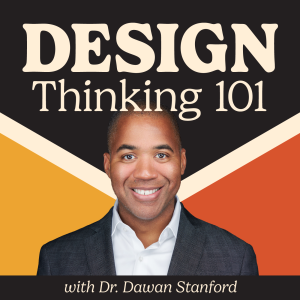
Micro Course: How to Conduct Listening Sessions with Indi Young — DT101 E64
 2021-03-02
2021-03-02
In this episode, Indi Young joins me to deliver a micro-course on listening sessions. I’m experimenting with new ways to learn on the podcast.
Listeners will learn from Indi as we talk about listening sessions, what they are, how to do them, why they matter, and how to get the most out of them.
Let me know what you think of the micro-course format, and if I should do more of them.
Cheers,
Dawan, Your Design Thinking 101 Podcast Host
Listen to learn more about:
- What listening sessions are and why they matter
- How to structure a good listening session
- Getting the most out of listening sessions
- The two questions that are always asked during a listening session
- Do’s and Don’ts of listening sessions
Our Guest’s Bio
Indi Young is a researcher who coaches, writes, and teaches about inclusive product strategy. Her work is rooted in the problem space where the focus is on people, not users. Indi pioneered opportunity, maps, mental model diagrams, and thinking styles. She was one of the founders of Adaptive Path, the pioneering user experience agency. Her way of approaching the problem allows teams to truly pay attention to people without letting cognitive bias and assumptions creep in. She has written two books, Practical Empathy, and Mental Models, and is working on a third, Assumptions Aside, which will cover thinking styles. Indi builds knowledge and community via a series of online advanced courses about design research and the importance of pushing the boundaries of your perspective.
Show Highlights
[02:54] Listening is different from interviewing.
[03:22] Listening is qualitative research.
[04:35] Indi describes the knowledge creation / data collection template she uses.
[05:05] Problem spaces and solution spaces.
[06:57] In the solution space, much of the research is either generative or evaluative.
[08:07] In the problem space, the research is neither generative nor evaluative.
[08:54] The problem space is interested in the person and how they achieve their purpose.
[09:19] A listening session asks the person what they were thinking as they were achieving their purpose.
[11:25] Organizations are often only concerned with solution spaces; problem spaces tend to get ignored.
[12:03] Why study problem spaces?
[12:56] One solution does not fit all – there is no such thing as an “average user.”
[13:50] Thinking styles vs. personas, and designing for archetypes.
[15:03] An example from work Indi did for the University of Buffalo.
[15:33] The benefits of using thinking styles over personas.
[16:25] The bias problem in research.
[17:10] Listening sessions must be framed by a purpose, and must have depth.
[17:39] Surface vs. depth.
[18:59] Depth is how we develop cognitive empathy with people.
[19:34] The good stuff in a listening session is the inner thinking, the emotional reactions.
[21:13] Indi describes the Mental Model Diagram.
[23:27] Listening sessions start with a germinal question.
[24:28] Listening sessions are audio-only.
[26:49] The challenges that can come up in listening sessions.
[28:47] The structure of a listening session.
[30:27] Indi shares snippets of some listening sessions as examples of how to begin a listening session.
[34:37] How Indi works with the results of a listening session.
[35:14] Techniques used during listening sessions.
[36:13] Listening session examples demonstrating techniques Listeners can use to build trust and rapport with the Speaker.
[38:05] The importance of silence.
[41:29] Listening session examples demonstrating how to encourage Speakers to open up and share their inner thoughts and emotions.
[45:38] Indi talks about micro-reflections and shares some examples from listening sessions.
[49:57] Why Indi likes the word “because.”
[50:43] Listening session examples where the Listeners used time and place to help the Speakers dig deeper.
[Note from Indi at 51:44] - “I forgot to explain that the grocery store example was because the Speaker got flustered and forgot her restaurant experiences. The Listener took her back to the grocery store she had mentioned so that the Speaker could be in familiar territory and relax. After that she remembered some more of her restaurant experiences.”
[55:34] Indi talks about ways to simply encourage Speakers to continue talking.
[57:12] Things not to do during listening sessions.
[57:18] Avoid asking leading questions.
[58:37] Avoid asking surface level questions.
[1:01:08] Avoid conjecture.
[1:01:51] Examples of conjecture from Indi’s listening sessions.
[1:08:32] Avoiding complex reflection.
[1:10:33] Indi talks about normal things that can occur during listening sessions.
[1:12:13] Discovering your own verbal habits when reviewing your listening sessions.
[1:13:35] Winding down listening sessions, and some examples of that from Indi.
[1:13:53] The one closing question you should always ask.
[1:16:40] Indi offers advice to those wanting to improve their listening skills and perhaps try using listening sessions.
[1:19:44] Indi talks about some of the courses she offers.
Links
Here are the diagrams and transcripts we discuss in the episode.
Indi on Twitter
Indi on LinkedIn
Indi on Medium
Indi’s website and course listings
99% Invisible podcast episode: On Average
Book Recommendation: Listening Well: The Art of Empathic Understanding, by William Miller
Be sure to check out the links from Indi’s other DT 101 Podcast episode, linked below!
Other Design Thinking 101 Episodes You Might Like
Problem Spaces, Understanding How People Think, and Practical Empathy with Indi Young — DT101 E6
More Episodes
Create your
podcast in
minutes
- Full-featured podcast site
- Unlimited storage and bandwidth
- Comprehensive podcast stats
- Distribute to Apple Podcasts, Spotify, and more
- Make money with your podcast
It is Free
- Privacy Policy
- Cookie Policy
- Terms of Use
- Consent Preferences
- Copyright © 2015-2024 Podbean.com





